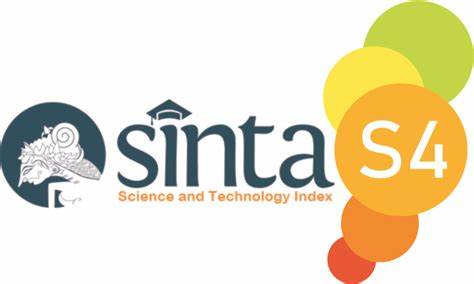UJI KELAYAKAN E-MODUL DENGAN MENGGUNAKAN APLIKASI SIGIL PADA MATERI FENOMENA KUANTUM KELAS XII SMA
Abstract
Abstract
The research was conducted to obtain products in the form of e-modules with the E-PUB format which were made using the sigil application on quantum phenomena material for class XII SMA. E-module with sigil application supports text, images, audio and video. This e-module learns about black body radiation, photoelectric effect, Compton effect and x-ray. The research method adopted the Research and Development (R&D) method with the ADDIE model. The ADDIE model is divided into five stages, namely analysis, design, development, implementation and evaluation. This research was conducted from the analysis, design to development stages. The data source was obtained from the scores of the questionnaire assessment results in the form of a checklist filled in by 3 expert validators. There are 4 aspects of the assessment carried out by the validator, namely aspects of content feasibility, linguistic aspects, presentation aspects and graphical aspects. The data obtained shows that the content feasibility aspect gets a score of 3.55 getting a very high category, the linguistic aspect has a score of 3.49 getting a high category, the presentation aspect has a score of 3.66 getting a very high category, and the graphical aspect has a score of 3.33 getting high category. So that the total average score of all aspects is 3.51 with a very high category. The conclusion from this study is that the e-module using the sigil application on quantum phenomena material for class XII SMA is valid and feasible to carry out for further research, namely the field trial stage, namely the implementation stage.
References
Aththibby, A. R., & Salim, M. B. (2015). Pengembangan Medıa Pembelajaran Fısıka Berbasıs Anıması Flash Topık Bahasan Usaha Dan Energı. Jurnal Pendidikan Fisika, 3(2), 25–33.
Budyastuti, Y., & Fauziati, E. (2021). Penerapan Teori Konstruktivisme pada Pembelajaran Daring Interaktif. Jurnal Papeda, 3(2), 112–119.
Dewi, Rr. V. K., Sunarsi, D., & Akbar, I. R. (2020). Dampak Penggunaan Teknologi Informasi dan Komunikasi Terhadap Minat Belajar Siswa di SMK Ganesa Satria Depok. Jurnal Ilmiah Wahana Pendidikan, 6(4), 1001–1007.
Falziah, Natalina, M., & Arnentis. (2015). Pengembangan Perangkat Pembelajaran Berorientasi Pendekatan Saintifik pada Materi Pertumbuhan dan Perkembangan di Kelas XII SMA. Jurnal Online Mahasiswa, 2(1), 1–11.
Ghiffary, M. A. (2019). Keefektıfan Game Kuıs Tts Pıntar Sebagaı Medıa Pembelajaran Mata Pelajaran Ipa Terpadu Dı Smp Islam Cahaya Insanı Semarang [Skripsi]. Universitas Negeri Semarang.
Ghozali, I. (2017). Pendekatan Scientific Learning dalam Meningkatkan Prestasi Belajar Siswa. Jurnal Pedagogik, 04(01), 1–13.
Jannah, J., Kaspul, K., & Utami, N. H. (2022). Kepraktisan Modul Elektronik Menggunakan Aplikasi Sigil Berorientasi Pendekatan Saintifik Materi Perubahan Lingkungan Kelas X Jenjang Sekolah Menengah Atas. JURNAL Al-AZHAR INDONESIA SERI SAINS DAN TEKNOLOGI, 7(3), 155. https://doi.org/10.36722/sst.v7i3.1091
Karimatussalamah, S. (2018). Pengembangan Modul IPA untuk Materi Mendeskripsikan Struktur Bumi Siswa Kelas V [Artikel Skripsi]. In Artikel Sripsi Universitas Nusantara PGRI Kediri. Universitas Nusantara PGRI Kediri.
Laili, I., Ganefri, & Usmeldi. (2019). Efektivitas Pengembangan E-modul Project Based Learning pada Mata Pelajaran Instalasi Motor Listrik. Jurnal Ilmiah Pendidikan Dan Pembelajaran, 3(3), 306–315.
Nuraini, E., Budi Susila, A., & Sunaryo. (2022). Pengembangan E-modul Fisika Berbasis CMS Wordpress pada Materi Konsep dan Fenomena Kuantum SMA Kelas XII. Prosiding Seminar Nasional Fisika (e-Journal) SNF2022, 10(1), 1–6. https://doi.org/10.21009/03.SNF2022
Rahmini, Y., Anaperta, M., & Yanti, I. R. (2017). Pengaruh Penerapan Teka Tekı Sılang Dalam Pembelajaran Dıscovery Learnıng Terhadap Hasıl Belajar Fısıka Sıswa Kelas XI MIPA SMA NEGERI 14 Padang. Education and Science Physics Journal E-ISSN, 3(2), 75–86. http://ejournal.stkip-pgri-sumbar.ac.id/index.php/JRFES
Rofiyadi, Y. A., & Lestari Handayani, S. (2021). Pengembangan Aplikasi E-Modul Interaktif Berbasis Android Materi Sistem Peredaran Darah Manusia Kelas V Sekolah Dasar. Jurnal Pendidikan Dasar Indonesia, 6(2), 54–60.
Sari, M., Amin, A., & Arini, W. (2021). Pengembangan Lembar Kerja Siswa Fisika Berbasis Scientific pada Materi Elastisitas dan Hukum Hooke. Sılamparı Jurnal Pendıdıkan Ilmu Fısıka, 3(1), 15–28. https://doi.org/10.31540/sjpif.v3i1.1045
Sari, S. A. (2016). Pengembangan Buku Dıgıtal Melaluı Aplıkası Sıgıl Pada Mata Kulıah Cookıes Dan Candys. Jurnal Science Tech, 1(2), 46–54.
Satriawati, H. (2015). Pengembangan E-modul Interaktif sebagai Sumber Belajar Elektronika Dasar Kelas X SMKN 3 Yogyakarta [Skripsi]. Universitas Negeri Yogyakarta.
Serway, R. A., & Vuille, C. (2012). College Physics (Ninth Edition). Charles Hartford.
Sugiyono. (2019). Metode Penelitian Kuantitatif Kualitatif dan R&D (9th ed.). Alfabeta.
Sugrah, N. (2019). Implementasi Teori Belajar Kontruktivisme dalam Pembelajaran Sains. Humanika, 19(2), 121–138.
Sukiman. (2008). Teori Pembelajaran dalam Pandangan Kontruktivisme dan Pendidikan Islam. Kependidikan Islam, 3(1), 59–70.
Suparlan. (2019). TEORI KONSTRUKTIVISME DALAM PEMBELAJARAN. Jurnal Keislaman Dan Ilmu Pendidikan, 1(2), 79–88. https://ejournal.stitpn.ac.id/index.php/islamika
Taluke, D., Lakat, R. S. M., & Sembel, A. (2019). Analısıs Preferensı Masyarakat Dalam Pengelolaan Ekosıstem Mangrove Dı Pesısır Pantaı Kecamatan Loloda Kabupaten Halmahera Barat. Jurnal Spasial, 6(2), 531–540.
Tegeh, I. M., & Kirna, I. M. (2013). Pengembangan Bahan Ajar Metode Penelitian dengan ADDIE Model. Jurnal IKA, 11(1), 12–26. https://doi.org/https://doi.org/10.23887/ika.v11i1.1145
Umar, H. (2011). Metode Penelitian untuk Skripsi dan Tesis Bisnis.
Zulkarnain, A., Kadaritna, N., & Tania, L. (2015). Pengembangan E-Modul Teorı Atom Mekanıka Kuantum Berbasıs Web Dengan Pendekatan Saıntıfık. Jurnal Pendidikan Dan Pembelajaran Kimia, 4(1), 222–235.






.png)







